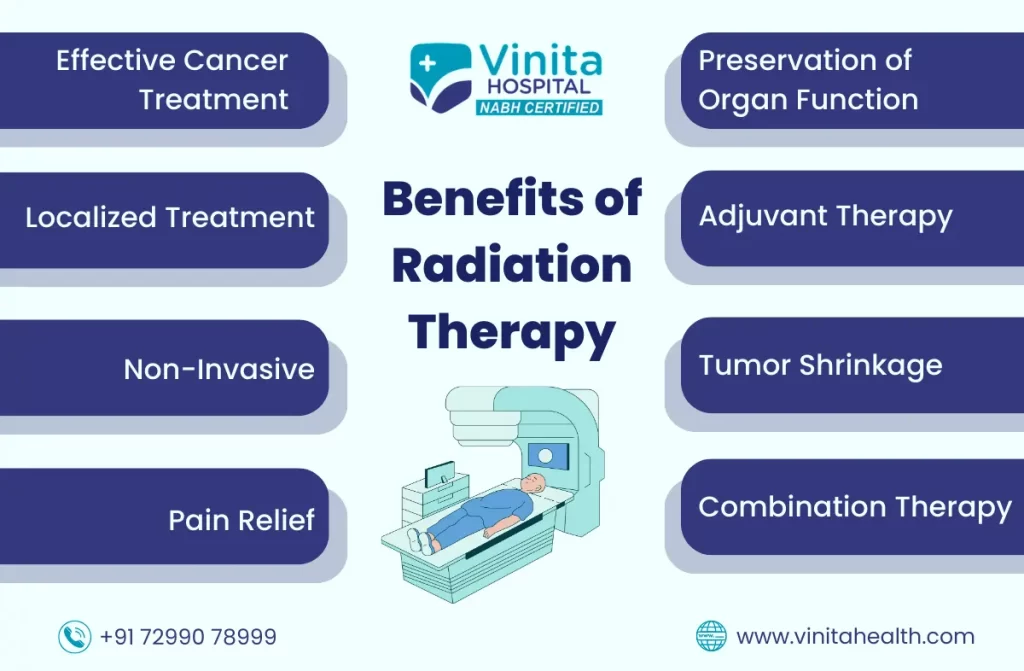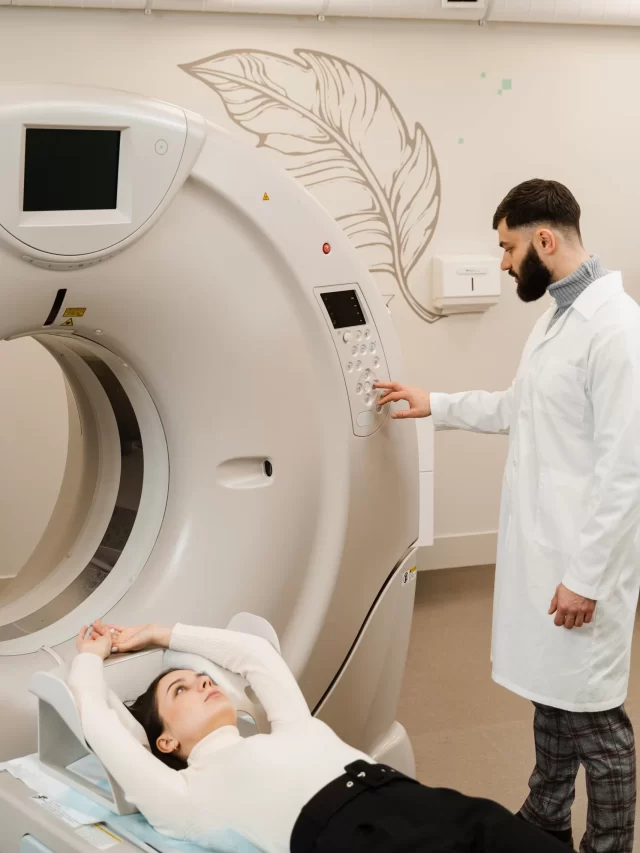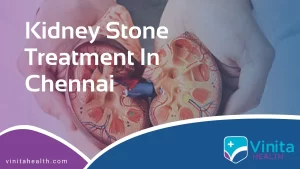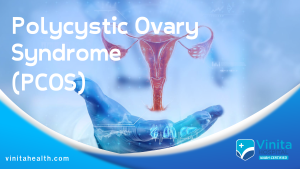Radiation therapy is an essential component of cancer treatment, and Chennai, India, boasts several well-established healthcare institutions that offer this service. If you’re thinking about undergoing radiation therapy in Chennai, consider reaching out to Vinita Hospital. Here, you’ll have access to cutting-edge radiation therapy resources, a team of exceptionally skilled medical experts, and a comprehensive array of cancer treatment alternatives.
What is Radiation Therapy?
Radiotherapy or radiation therapy is a crucial medical treatment used in the management of various diseases, primarily cancer. This therapy employs high-energy radiation to target and destroy cancer cells or to shrink tumors.
Why is Radiation Therapy Done?
Radiation therapy is performed for several reasons. Radiation therapy in Chennai is done for the following purposes:
1. Cancer Treatment: The primary goal of radiation therapy is to treat cancer. It can be used as the sole treatment method or in combination with surgery, chemotherapy, or immunotherapy, depending on the type and stage of cancer. Radiation therapy is often chosen when cancer is localized or when surgery is not an option.
2. Tumor Shrinkage: Radiation therapy can be used before surgery to shrink tumors, making them easier to remove. This is known as neoadjuvant therapy.
3. Palliative Care: In cases where cancer cannot be completely cured, radiation therapy can provide palliative care. It helps alleviate symptoms and improve the quality of life by reducing tumor size and relieving pain and discomfort at an affordable radiation therapy cost in Chennai.
4. Adjuvant Therapy: After surgery to remove a tumor, radiation therapy may be administered to destroy any remaining cancer cells and reduce the risk of cancer recurrence.

Procedure of Radiation Therapy
The process involved for radiation therapy in Chennai typically involves several steps including:
Consultation and Planning
The process begins with a consultation with a radiation oncologist, who specializes in radiation therapy. During the radiation therapy in Chennai, an oncologist reviews the patient’s medical history, conducts physical examinations, and assesses diagnostic imaging such as CT scans and MRI. A treatment plan is then developed based on the cancer type, stage, location, and the patient’s overall health.
Simulation
During simulation, the patient is positioned precisely on the treatment table to ensure accurate targeting of the tumor. Immobilization devices like molds or masks may be used to keep the patient in the same position for each treatment session. Imaging techniques such as CT or MRI scans are performed at a reasonable radiation therapy cost in Chennai to map the tumor’s exact location.
Treatment Planning
Using the simulation data, the radiation oncology team calculates the optimal radiation dose and treatment angles to maximize the dose to the tumor while sparing surrounding healthy tissue. Advanced computer software is employed to design the treatment plan.
Radiation Delivery
Radiation therapy in Chennai can be delivered in various ways, including external beam radiation and internal radiation (brachytherapy). External beam radiation is the most common method, involving a machine called a linear accelerator that directs radiation beams at the tumor from various angles. The patient typically receives treatments over several weeks, with daily sessions lasting only a few minutes.
Benefits of Radiation Therapy in Chennai
There are various benefits of radiation therapy in Chennai. They include:
- Targeted Treatment: Radiation therapy precisely targets the tumor, minimizing damage to nearby healthy tissue.
- Curative Potential: Radiation therapy can cure cancer in some cases, especially when the disease is localized.
- Palliative Care: For advanced cancers, radiation therapy can significantly improve the patient’s quality of life by reducing pain and other symptoms.
- Combined Therapy: It can be used in conjunction with surgery and chemotherapy to increase treatment effectiveness.
- Non-Invasive: Unlike surgery, radiation therapy is a non-invasive treatment option making the radiation therapy cost in Chennai cost-effective.
Risks and Side Effects
Radiation therapy in Chennai is an effective cancer treatment, but it does come with potential risks and side effects that include:
- Skin Reactions: Redness, irritation, and blistering of the skin may occur in the area exposed to radiation.
- Fatigue: Patients often experience fatigue during and after radiation therapy.
- Nausea and Vomiting: Depending on the treatment area, some patients may experience nausea and vomiting.
- Hair Loss: Hair loss may occur in the treatment area, but it is usually temporary.
- Long-term Effects: Radiation therapy can have long-term effects on surrounding organs, potentially leading to complications like fibrosis or secondary cancers, though these risks are generally low.
- Sexual and Fertility Issues: Radiation near the reproductive organs can affect fertility and sexual function.
Types of Radiation Therapy
- External Beam Radiation Therapy (EBRT): Administers radiation from outside the body using machines like linear accelerators.
- Internal Radiation Therapy (Brachytherapy): Places radioactive sources directly inside or near the targeted area.
- Intensity-Modulated Radiation Therapy (IMRT): Delivers precise radiation doses, adjusting intensity based on tumor shape.
- Image-Guided Radiation Therapy (IGRT): Uses imaging to verify and adjust radiation delivery in real time.
- Stereotactic Body Radiation Therapy (SBRT): Provides high doses in fewer sessions for small, well-defined tumors.
- Proton Therapy: Utilizes protons for targeted radiation, minimizing damage to surrounding healthy tissues.
- Volumetric Modulated Arc Therapy (VMAT): Delivers radiation while the machine rotates around the patient, optimizing treatment efficiency.
Advanced Radiation Therapy Techniques
- Stereotactic Radiosurgery (SRS): Precisely targets small brain tumors or abnormalities in a single, high-dose session.
- Stereotactic Body Radiation Therapy (SBRT): Delivers highly focused radiation to extracranial tumors, completing treatment in a few sessions.
- Proton Therapy: Utilizes protons instead of photons for precise cancer targeting, reducing damage to surrounding healthy tissues.
- Intensity-Modulated Radiation Therapy (IMRT): Adjusts radiation beam intensity in multiple directions, customizing doses to the tumor’s shape.
- Image-Guided Radiation Therapy (IGRT): Incorporates imaging during treatment to enhance accuracy and adjust for patient positioning changes.
- Volumetric Modulated Arc Therapy (VMAT): Optimizes radiation delivery with continuous motion, improving treatment efficiency and precision.
Results and Follow-up
The effectiveness of radiation therapy in Chennai varies depending on factors such as the type and stage of cancer. Some expected outcomes include:
- Tumor Shrinkage: In many cases, radiation therapy leads to a reduction in tumor size.
- Pain Relief: Patients often experience reduced pain and improved overall well-being.
- Cure: Radiation therapy can lead to a complete cure in some cases, especially when cancer is localized.
- Adjunct to Other Therapies: It complements surgery and chemotherapy by targeting residual cancer cells.
- Long-term Monitoring: After treatment, patients are closely monitored to assess the treatment’s success and manage any side effects or complications.
Conclusion
To conclude, radiation therapy in Chennai at Vinita Hospital offers curative potential and enhanced quality of life for advanced cases. While it presents risks and side effects, its benefits usually outweigh them, when part of a comprehensive plan. Collaboration between patients, oncologists, and radiation teams is vital for optimal outcomes.
Read also Symptoms of Urine Stone.






